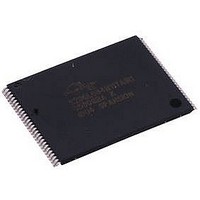S29GL01GP13FFIV10 Spansion Inc., S29GL01GP13FFIV10 Datasheet - Page 34

S29GL01GP13FFIV10
Manufacturer Part Number
S29GL01GP13FFIV10
Description
IC, FLASH, 1000MBIT, 130NS, TSOP-64
Manufacturer
Spansion Inc.
Datasheet
1.S29GL01GP13FFIV10.pdf
(80 pages)
Specifications of S29GL01GP13FFIV10
Memory Type
Flash
Memory Size
1000Mbit
Memory Configuration
128K X 16
Ic Interface Type
Parallel
Access Time
130ns
Supply Voltage Range
2.7V To 3.6V
Memory Case Style
TSOP
No. Of Pins
64
Cell Type
NOR
Density
1Gb
Access Time (max)
130ns
Interface Type
Parallel
Boot Type
Not Required
Address Bus
27/26Bit
Operating Supply Voltage (typ)
3/3.3V
Operating Temp Range
-40C to 85C
Package Type
Fortified BGA
Sync/async
Asynchronous
Operating Temperature Classification
Industrial
Operating Supply Voltage (min)
2.7V
Operating Supply Voltage (max)
3.6V
Word Size
8/16Bit
Number Of Words
128M/64M
Supply Current
110mA
Mounting
Surface Mount
Pin Count
64
Lead Free Status / RoHS Status
Lead free / RoHS Compliant
34
7.7.6
Program Suspend/Program Resume Commands
The Program Suspend command allows the system to interrupt an embedded programming operation or a
“Write to Buffer” programming operation so that data can read from any non-suspended sector. When the
Program Suspend command is written during a programming process, the device halts the programming
operation within 15 µs maximum (5 µs typical) and updates the status bits. Addresses are “don't-cares” when
writing the Program Suspend command.
After the programming operation has been suspended, the system can read array data from any non-
suspended sector. The Program Suspend command may also be issued during a programming operation
while an erase is suspended. In this case, data may be read from any addresses not within a sector in Erase
Suspend or Program Suspend. If a read is needed from the Secured Silicon Sector area, then user must use
the proper command sequences to enter and exit this region.
The system may also write the Autoselect Command Sequence when the device is in Program Suspend
mode. The device allows reading Autoselect codes in the suspended sectors, since the codes are not stored
in the memory array. When the device exits the Autoselect mode, the device reverts to Program Suspend
mode, and is ready for another valid operation. See
After the Program Resume command is written, the device reverts to programming. The system can
determine the status of the program operation using the write operation status bits, just as in the standard
program operation. See
The system must write the Program Resume command (address bits are “don't care”) to exit the Program
Suspend mode and continue the programming operation. Further writes of the Program Resume command
are ignored. Another Program Suspend command can be written after the device has resumed programming.
Software Functions and Sample Code
The following is a C source code example of using the program suspend function. Refer to the Spansion Low
Level Driver User’s Guide (available on www.spansion.com) for general information on Spansion Flash
memory software development guidelines.
The following is a C source code example of using the program resume function. Refer to the Spansion Low
Level Driver User’s Guide (available on www.spansion.com) for general information on Spansion Flash
memory software development guidelines.
/* Example: Program suspend command */
/* Example: Program resume command */
*( (UINT16 *)base_addr ) = 0x00B0;
*( (UINT16 *)base_addr ) = 0x0030;
Cycle
Cycle
1
1
Operation
Operation
Write Operation Status on page 36
Write
Write
S29GL-P MirrorBit
(LLD Function = lld_ProgramSuspendCmd)
(LLD Function = lld_ProgramResumeCmd)
Table 7.12 Program Suspend
Table 7.13 Program Resume
Byte Address
Byte Address
Base + XXXh
Base + XXXh
/* write suspend command
/* write resume command
D a t a
®
Flash Family
Autoselect on page 21
S h e e t
for more information.
Word Address
Word Address
Base + XXXh
Base + XXXh
S29GL-P_00_A13 November 17, 2010
for more information.
*/
*/
00B0h
0030h
Data
Data















